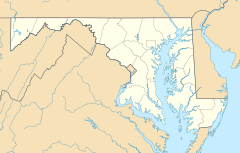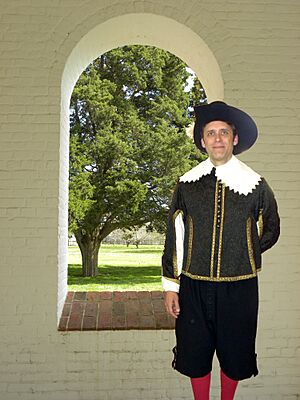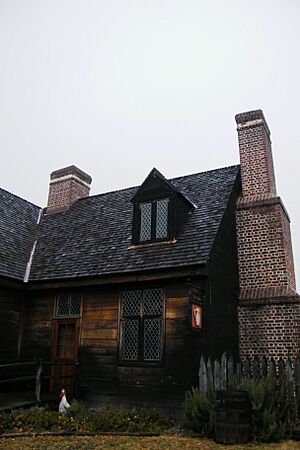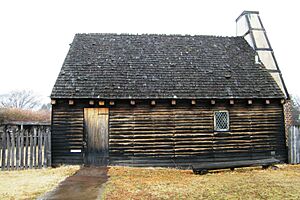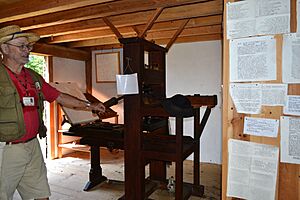St. Mary's City, Maryland facts for kids
Quick facts for kids
St Mary's City, Maryland
|
|
|---|---|
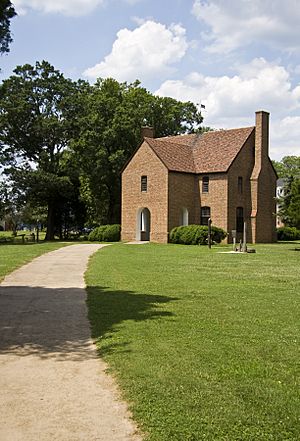
"The State House", a reconstruction of the original 1676 Maryland Statehouse, Maryland's first capitol building and also the home of the Maryland colonial assembly, which stands near the original site.
|
|
| Country | |
| State | |
| County | |
| Founded | March 27, 1634 |
| Founded by | Leonard Calvert |
| Area | |
| • Total | 1.20000 sq mi (3.10799 km2) |
| • Land | 1.10000 sq mi (2.84899 km2) |
| • Water | 0.100000 sq mi (0.258999 km2) |
| Population
(2010)
|
|
| • Total | 933 year round residents plus about 1,400 student residents during spring and fall semesters |
| Time zone | Eastern (EST) |
| • Summer (DST) | eastern (Americas) |
| ZIP code |
20686
|
Birthplace of religious freedom in North America with the passage of the Maryland Act of Toleration in 1649. The first place where a (possibly) African American person, Mathias De Sousa, served in an assembly as a voting legislator and first place where a woman, Margaret Brent, petitioned (unsuccessfully) for the right to vote. |
|
|
St. Mary's City Historic District
|
|
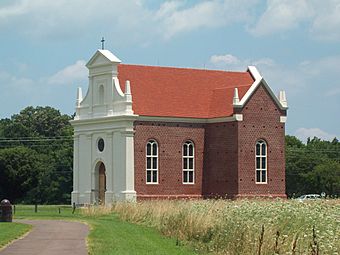
St. Mary's City Historic District: Reconstructed 1667 Catholic Church, built on site of the original Jesuit mission church in the St. Mary's City colonial settlement, Maryland's first colony.
HSMC, July 2009 |
|
| Nearest city | St. Mary's City, Maryland |
| Built | c. 1667. Rebuilt 2009. |
| NRHP reference No. | 69000310 |
| Significant dates | |
| Added to NRHP | August 4, 1969 |
| Designated NHLD | August 4, 1969 |
St. Mary's City, also known as Historic St. Mary's City, was Maryland's first European settlement and capital. It was founded in March 1634. Today, it is a special state-run historic area. This area includes a recreated colonial town and a museum complex where history comes alive. About half of the area is home to St. Mary's College of Maryland. The community has around 933 permanent residents and about 1,400 students.
This area is an unincorporated community in southern St. Mary's County. It sits on the southernmost tip of Maryland, near the Chesapeake Bay. The St. Mary's River borders the community. This river is a short, salty waterway that flows into the Potomac River and then into the Chesapeake Bay.
St. Mary's City is famous as the founding place of the Province of Maryland. It was the colonial capital from 1634 until 1695. It is also the fourth oldest permanent English settlement in the United States.
A very important fact about St. Mary's City is that it was the first place in North America to establish religious freedom. It was created as a safe place for both Catholic and Protestant Christians.
The city is also a globally recognized place for archaeological research. It's a training center for archaeologists and hosts the Historical Archaeology Field School. Over the last 30 years, more than 200 archaeological digs have happened here. Research continues to this day.
Contents
- Exploring Historic St. Mary's City
- St. Mary's College: A Special School
- The Story of St. Mary's City
- Archaeological Research in St. Mary's City
- See also
Exploring Historic St. Mary's City
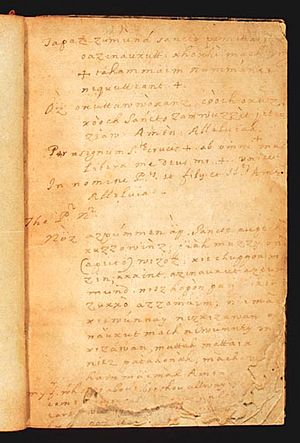
Historic St. Mary's City is a large public area where you can learn about history. It has four public museums. It shows what the original colonial capital of Maryland and the first settlers' village looked like.
The area has several living history museums. Actors dressed in old-fashioned clothes bring history to life. Archaeologists and students also explain the science and history. You can see public archaeological sites and reconstructed colonial buildings. There are outdoor historical reenactments all year. You can also visit a working colonial farm and a full-sized replica of The Dove sailing ship. This ship was one of the two original ships that brought the first Maryland colonists.
Historic St. Mary's City also teaches about the life of woodland Native Americans from the colonial era. Sometimes, members of the Piscataway Indian Nation perform reenactments and cultural shows. The Piscataway people lived here first. They became friends with and helped the early colonists.
The area also hosts summer plays with historical themes and other special events. The State of Maryland owns Historic St. Mary's City. It is run by a nonprofit group. Besides tourists, the organization welcomes over 20,000 students on field trips each year.
The "Historic St. Mary's City Commission," a Maryland state agency, manages Historic St. Mary's.
St. Mary's College: A Special School
St. Mary's College of Maryland is a public college that offers special honors programs. It is a state-funded school for undergraduate students. It is one of only two "Public Honors Colleges" in the United States. It is also one of a few small public liberal arts colleges. The state of Maryland wanted it to be like expensive private colleges. This way, students could get a great education without the high cost.
The school is not religious. Its name honors the original colonial settlement. Half of that settlement was located where the college now stands.
In 2014, U.S. News & World Report ranked St. Mary's College as 5th in the nation. This was in the "Top Public Schools" category for colleges.
The Story of St. Mary's City
How St. Mary's City Began
George Calvert's Dream
Colonial St. Mary's City was first imagined by an English Lord named George Calvert. He was born into a Catholic family in England. At that time, Catholics faced difficulties in England. Calvert wanted to create a colony in North America. His dream was to make it a safe place for persecuted Catholics.
He first tried to start a colony in Newfoundland in 1621. But he later decided a warmer place would be better. In 1631, King Charles I gave Calvert a special grant of land. This was to thank him for his service to the country.
Cecil Calvert Continues the Plan
George Calvert passed away just before the Maryland charter was officially approved. However, the King gave the land grant to his oldest son, Cecil. Cecil Calvert continued his father's plans. He wanted the colony to be a safe place for Catholics, but also to make money.
Supporters of the Virginia colony did not want a new colony nearby. So, Cecil stayed in England to handle these political issues. He sent his younger brother, Leonard Calvert, to lead the settlers instead. Cecil himself never visited Maryland.
Leonard Calvert spent the rest of his life in Maryland. He guided the settlers through many challenges and helped them succeed. They grew and sold tobacco back to Britain. Leonard is truly seen as the founder of colonial Maryland.
The Ships: The Ark and The Dove
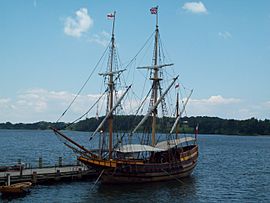
In November 1633, two ships, The Ark and The Dove, sailed from the Isle of Wight. They carried settlers, Jesuit missionaries, and indentured servants. After a long journey, they arrived in Maryland in March 1634.
They chose to settle on a high piece of land overlooking the St. Mary's River. This river was a calm, tidal waterway near where the Potomac River meets the Chesapeake Bay.
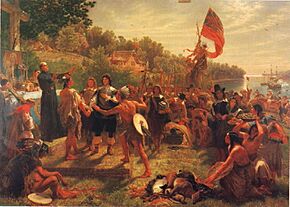
The site had been used by the Yaocomico people, a branch of the Piscataway Indian Nation. They had left the area because they feared attacks from the Susquehanna tribe. The English settlers had a former Virginia colonist with them who spoke the Yaocomico language. They quickly met with the chief of the region. The chief, Tayac Kittamaquund, sold thirty miles of land to the English. He hoped to make them allies and trading partners. The Piscataway and the English Marylanders lived peacefully together for some time.
Naming St. Mary's City
The new settlement was officially named and founded as St. Mary's City on March 27, 1634. The name came from King Charles I's suggestion to honor his queen, Henrietta Maria. The original group of 300 settlers was mostly English, with some Irish. There may have also been a person of mixed African and European heritage. Other indentured servants came from England and Ireland.
This group included both Catholics and Protestants. This was during a time when Catholics faced difficulties in the British Isles. Leonard Calvert, a Roman Catholic, became the first governor of the new colony. St. Mary's City became the capital of the new Maryland colony. It remained the capital for 61 years, until 1694.
First Maryland Assembly
Maryland's first legislative assembly met in 1634 and continued into 1635. This was the first non-Native legislative body in Maryland. The assembly soon began to question some of Cecil Calvert's rules. However, they did not challenge his ownership of the colony or his rule for religious tolerance.
They successfully pushed for more personal freedoms. They also wanted to adapt Calvert's rules to the real conditions in the colony. For example, Calvert wanted them to live closely inside the new fort. But the assembly felt it was more important to allow for spread-out farming. Leonard Calvert supported the assembly's wishes in letters to his brother. Cecil Calvert mostly agreed.
Mathias de Sousa was a settler described as "mulatto" (mixed African and European heritage). He first arrived as an indentured servant for the Jesuit missionaries. He later gained his freedom and became an assemblyman. This makes him possibly the first person of African heritage to serve in a legislative body in North America.
Early Rules for Religious Tolerance
George Calvert, the First Lord Baltimore, gave instructions in 1633. He said the new governor and all settlers must practice religious tolerance. After George Calvert's death, his son Cecil Calvert, the new Lord Baltimore, also gave instructions for religious tolerance. These were sent with his younger brother Leonard Calvert, who became the first governor. These instructions also told Catholics to be quiet about their faith. This was to avoid upsetting Protestants. These rules became Maryland's first laws.
Most early settlers continued this idea. In 1649, their first legislative assembly passed the Maryland Toleration Act. This law further protected religious freedom.
Maryland's First Colonial Town
The original St. Mary's settlement was planned in a Baroque style. Settlers lived close together in a town with a church, stores, and homes. Farms, fields, woods, and orchards were laid out in a grid around it. However, most residents later preferred to live on their tobacco plantations in the countryside. The settlement was meant to be the capital of the new Maryland Colony.
Growth and Challenges
Tobacco Success and Slavery
St. Mary's City saw a big economic boost from successful tobacco farming. Tobacco became a very valuable crop. This also led to more African slavery. Older rules that allowed enslaved people to gain freedom were removed. The colony slowly became more dependent on slavery.
As the town grew, more public buildings were built. These included a state house, a Jesuit chapel, a jail, and an inn.
Growing Religious Tensions
During and after the English Civil War, conflicts grew between Protestants and Catholics in the colony. These tensions often came and went. Sometimes they were quiet, and other times they flared up. These conflicts sometimes caused big changes in St. Mary's City and Maryland.
Margaret Brent's Bold Actions
Margaret Brent was a smart and successful Catholic settler in St. Mary's City. She managed her own business affairs, which was unusual for women at that time. She also came to the colony as a single, unmarried woman.
The law supported Brent's rights, but common beliefs often did not. Especially in the male-dominated colonies, far from England's courts. She had to defend her legal rights to ensure they were respected.
Brent argued her case in court before the assembly in St. Mary's City. She made a strong case and won. This made her the first woman in English North America to represent herself in court and before an assembly. She also asked for the right to vote in the assembly, but this was denied.
Brent also worked as an attorney in the colonial court. She mostly represented women. She was known for being very skilled in law. Records show she argued at least 134 cases. While she didn't openly campaign for women's rights, her actions helped pave the way.
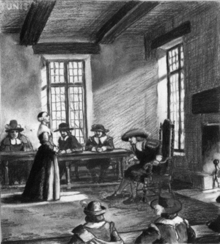
The Plundering Time
1644–1646: A Time of Trouble
The violence from the English Civil War reached the colonies. A group of Protestant raiders attacked St. Mary's City. They drove away many settlers and burned several buildings. After the attack, only about 100 people remained in the town. The raiders took control and added more defenses.
They stole from the homes of all Catholic residents who refused to change their faith. They also stole from anyone who was friends with a Catholic. The colonists later called this period the Plundering Time.
1647: Leonard Calvert Fights Back
Leonard Calvert had been away from St. Mary's City for a few years. He married Margaret Brent's sister during this time. This made Margaret Brent his sister-in-law. Nearly two years later, Leonard Calvert gathered a militia. He led an attack to take back St. Mary's City. They succeeded in driving off the Protestant militia and regained control.
Calvert then led successful raids on Kent Island, a stronghold of his enemies. He defeated the forces there. Calvert had the upper hand, but the threat remained. However, within a year, Leonard Calvert became ill and passed away. This created a temporary power vacuum in the colony. It also left Calvert's militia, which protected the city, unpaid.
Margaret Brent Steps In
Leonard Calvert named Margaret Brent as the executor of his will. This was a very unusual role for a woman at that time. She managed his estate. At the same time, Calvert's unpaid militia became a problem for St. Mary's City. If the soldiers left because they weren't paid, the city would be open to attack again.
So, Brent asked the Maryland Assembly to give her power over Cecil Calvert's property. Cecil was Leonard's brother, living in England. She then used money from selling some of these properties to pay the militiamen.
The Maryland assembly later said her actions were necessary in an emergency. They even said she might have saved the colony. However, Cecil Calvert did not approve of her spending his money.
The Maryland Assembly praised Brent, saying:
...the Colony was safer in her hands than any man's in the Province,
and she rather deserves favor and thanks for her so much concerning
[herself] for the public safety.
But Cecil Calvert was not convinced.
This disagreement also caused problems between the Calvert family and Brent. Brent's brother, Giles Brent, had married a Native American princess. In the same letter accusing Margaret Brent, Cecil Calvert also criticized her brother for this marriage. Cecil Calvert then ordered Brent and her siblings to leave the Maryland Colony.
Even though the assembly supported Brent, they denied her request to vote because she was a woman. This was the first known attempt by a woman in English North America to gain the right to vote.
Despite the assembly's support, Cecil Calvert insisted she leave. Brent left the colony with her sister. They lived on an island in the Potomac River for a year. Then they moved to the Virginia colony. Brent started a new estate there called "Peace." She became very successful and lived in Virginia for the rest of her life.
1649: Maryland Toleration Act Passed
The Maryland Toleration Act was created and passed by the Maryland assembly in St. Mary's City. It was the first law to require religious tolerance among different Christian groups (especially Catholics and Protestants). It fulfilled the wishes of George and Cecil Calvert for the colony to be a place of religious tolerance.
More importantly, the act aimed to end the religious conflicts that had caused recent fighting. The assembly at that time was mostly Protestant. However, the colony's leaders, including the governor, were Catholic.
The act stayed in effect for 40 years. It helped bring peace to the colony during that time.
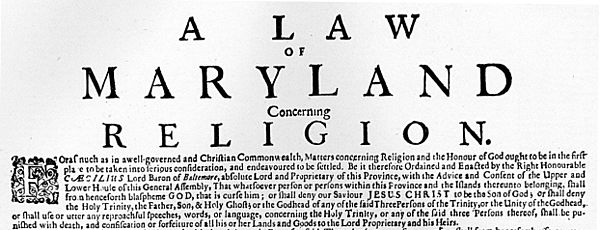
Challenges and Changes
1660s: Tobacco Problems
In the 1660s, tobacco prices started to drop. This was because other colonies produced more tobacco, creating more competition. Maryland planters tried to make up for lower prices by mixing other leaves with their tobacco. This helped for a short time. But it hurt Maryland tobacco's reputation in England and lowered its value even more.
These problems began to destabilize the Maryland Colony. They also made the hidden religious tensions worse. Most planters were Protestant, while the leaders were Catholic.
This situation also led to an increased reliance on slavery in St. Mary's City. Plantation owners wanted to cut the cost of paid labor to produce tobacco.
1676: Maryland Statehouse Built
In 1676, the original Maryland Statehouse was completed. This building housed the Maryland colonial assembly. The reconstructed statehouse you see today is not in the exact original spot. The original site is now under the churchyard of Trinity Episcopal Church. When the first statehouse was taken down in 1829, its bricks were used to build Trinity Church.
1678: First Printing House in the Southern Colonies
William and Dinah Nuthead moved to St. Mary's City in 1678. They became Maryland's first printers. Dinah Nuthead could not read or write, but she often helped her husband with the printing press. She learned by watching him. After William died in 1695, Dinah continued the printing business. She got a license from the colonial government, becoming the first female printer in the colony. When Dinah moved to Annapolis, Maryland in 1695, she kept her printing business going there.
The Decline of St. Mary's City
1689: Religious Conflict Erupts
In 1689, about 40 years after the Maryland Toleration Act, tensions between Protestants and Catholics became very high. Protestant settlers rebelled against the Lords Baltimore in what was called the Protestant uprising in Maryland. The English Crown took control of the Maryland colony. Royal governors replaced the Calvert family.
Religious tolerance, which was once law, was ended. First, the King ordered it. Then, a new assembly, mostly Protestant, passed a law to end it. This happened in the new capital, Annapolis.
1690s: Anti-Catholic Policies
In 1692, Catholics in the Maryland Colony lost the right to vote. They were also no longer allowed to worship in public. They could only worship in their private homes. Laws were also passed to limit new Roman Catholic immigration to the colony.
Catholics eventually got the right to vote back decades later. But other forms of discrimination against Catholics continued for most of the next century. These religious tensions in Maryland lasted even until the election of John F. Kennedy in the mid-20th century.
Capital Moves to Annapolis
The new Protestant Maryland governor, Sir Francis Nicholson, moved the capital. In 1695, it moved from St. Mary's City to the more central Annapolis. The colonial statehouse in St. Mary's was turned into a Protestant church that same year.
In 1695, St. Peters freehold, a former home of Maryland governors in St. Mary's City, was destroyed in an explosion. It's not known if this was on purpose or an accident. A large amount of gunpowder had been stored in its basement. This freehold had been the home of the new Protestant Governor Francis Nicholson for a short time. Before that, it was the home of Philip Calvert, the former Catholic Governor and Cecil Calvert's half-brother, until his death in 1682.
Anti-Catholic Policies in the 1700s
During the 1700s, Catholics became a group that faced difficulties in Maryland. They were not allowed to serve in the militia. They were taxed twice as much when money was needed for the military. They were also discouraged from moving to the colony. Wealthy Catholics often practiced their religion in secret. They sent their children abroad for Catholic schooling. But poor Catholics could not afford this. They were more likely to face discrimination. Over time, many converted to Protestantism to avoid these problems. By the late 1700s, the Catholic population had dropped to 9%.
The City Becomes Empty
With the government gone, the town no longer had a main purpose. Most remaining people were farmers. The old town center became farmland. The archaeological remains of the colonial town stayed hidden underground.
1700–1865: Plantation Era and Civil War
Early 1700s: Farms Combine
The small farms in St. Mary's City were combined into a large plantation by the Brome-Howard family. This slave plantation operated for most of the 1800s. The main plantation house was built over the ruins of one of the Calvert family homes.
The Civil War
During the American Civil War, Union troops occupied St. Mary's County. Like much of Maryland, the county had Southern sympathies. Union forces burned piers and wharves in St. Mary's County. This was to stop trade with the Confederacy, which was just across the Potomac River. Brome's Wharf in St. Mary's City was also burned. It was part of the Brome-Howard Plantation, owned by Doctor Brome, a slave-owner and likely Confederate supporter.
Archaeological evidence suggests the Union Army may have occupied the plantation for some time. Records show that Doctor Brome later complained that Union troops damaged his piano.
Records show that one-quarter of the 66 enslaved people on Doctor Brome's plantation escaped during the Civil War. At least two of them joined the Union Army. Even before slavery was officially ended, the Union Army allowed enslaved men to gain freedom by becoming soldiers. Other records show that 59 people were enslaved there during this time.
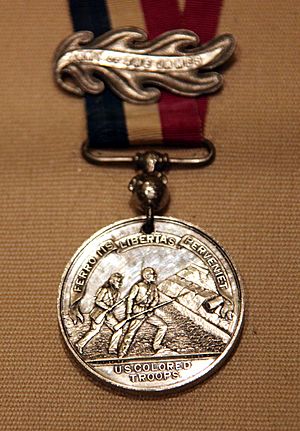
Two men who escaped slavery from the St. Mary's City area, Alexander Gough and William Gross, joined the famous 38th United States Colored Infantry Regiment of the Union Army. This regiment won awards for bravery in the Battle of Chaffin's Farm during the Civil War. Gough survived the war and lived the rest of his life in Baltimore. Two other African American men from the area, William H. Barnes and James H. Harris, were free tenant farmers before the war. They also served in the same regiment. Harris and Barnes each received the Medal of Honor for their actions in the Battle of Chaffin's Farm. Evidence suggests that more enslaved people from the Brome plantation also fought in the war. In total, over 700 African Americans from St. Mary's County served in the Union Army.
The United States Colored Troops Memorial Statue in Lexington Park, Maryland, honors these African American soldiers. It is seven miles north of St. Mary's City. It remembers the men from St. Mary's County who served in the Union Army or Navy. A plaque there specifically mentions Barnes and Harris and their Medals of Honor.
After the Civil War
The Civil War ended slavery on the plantation. The area remained a large farm, worked by tenant farmers. It was owned by descendants of the original owners until the 1900s. By the mid-20th century, few 17th-century buildings were still standing. The old town center looked like farmland, with a few homes. After 1840, a women's school slowly grew on a small part of the land.
Writings About St. Mary's City's Decline
In 1838, the novel Rob of the Bowl was published. It was a story about the struggle for religious tolerance in Maryland. The story was set in St. Mary's City and nearby St. Inigoes. The book begins with a poem that describes St. Mary's City long after it stopped being the capital.
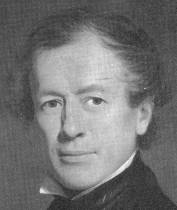
This poem refers to the idea that St. Mary's City was a place where great things happened. It was the birthplace of religious freedom in the United States. But it eventually became like a ghost town.
No more thy glassy brook reflects the day,
But choked with sedges, works its weedy way;
Along thy glades a solitary guest,
The hollow-sounding bittern guards its nest;
Amidst thy desert walks the lapwing flies,
And tires their echoes with unvaried cries.
Sunk are thy bowers in shapeless ruin all,
And the long grass o'ertops the mould'ring wall
The Deserted Village
St. Mary's City's Comeback
1840: St. Mary's Female Seminary Founded
The book Rob of the Bowl told a partly fictional story of old St. Mary's City. After the book became popular, the author wished there was a monument to remember the original city.
A few years later, in 1840, a non-religious high school for women was started. It was on the grounds of old St. Mary's City. This was in response to the author's call for a monument. Its founders called it a "living monument" to the start of religious tolerance. The school aimed to educate young women in the county and state. It was called St. Mary's Seminary.
The school was intentionally non-religious. This was to honor and promote religious tolerance. It also helped heal Protestant-Catholic tensions that still existed in St. Mary's County.
The name was later changed to St. Mary's Female Seminary. This made it clear that it was only for female students.
Early 1900s Changes
In 1926, the St. Mary's women's school expanded. It became a two-year junior college combined with the last two years of high school. This was seen as a natural step for the elite, state-funded women's high school.
Through a law passed by the Maryland Legislature, the school was opened to male students. The word "female" was removed from its name. However, while males could enroll, they were not offered housing. The school's name changed to St. Mary's Seminary Junior College.
The St. Mary's City Commission was created in 1966 by the State Assembly of Maryland and Governor Millard Tawes. This commission was a new state agency. It reported directly to the Governor. Its job was to "preserve, develop and maintain" St. Mary's City as a state "monument." It also oversaw ongoing archaeological work.
The Junior College was ordered to become a four-year institution in 1966 (starting in 1968). It was renamed "St. Mary's College of Maryland". It became a four-year public liberal arts college. Its goal was to offer a liberal arts education to students who couldn't afford expensive private colleges. The reorganization was finished in 1967.
1969: St. Mary's City Becomes a National Landmark
St. Mary's was declared a National Historic Landmark in 1969.
A plan suggested buying 1200 acres of land. It also recommended building a museum, visitor center, and a working tobacco farm. It proposed public transportation and rebuilding the Ark and Dove as first steps to recreate the historic city.
1976: Wings of the Morning Play Premieres
To celebrate the founding of St. Mary's City, a play called Wings of the Morning was created. It was an outdoor drama by Kermit Hunter. It featured characters like Leonard Calvert and Mathias de Sousa. This play launched the career of two-time Academy Award winner Denzel Washington, who played DeSousa in his first stage role.
1980–Present Day
After years of test digs and historical research, archaeologists narrowed down the possible locations of the original town. Digging increased to uncover the colonial settlement's layout.
In 1984, "Lord Baltimore's World" was a large, months-long colonial reenactment. It had professional actors and live Shakespearean theater. It celebrated the 350th anniversary of Maryland's first colonists.
After four years of intense digging, most of the original town layout was found. People expected it to be messy, but it was carefully planned in a Baroque style. This was similar to Williamsburg, Virginia and Annapolis Maryland. Old St. Mary's City, Annapolis, and Williamsburg are the only three towns in North America planned with a Baroque layout.
The St. Mary's City Commission's name changed in 1991 to the Historic St. Mary's Commission. This commission still manages about half of St. Mary's City. It is responsible for preserving over 800 acres of land and 3 miles of shoreline.
Today
Historic St. Mary's City is now a popular tourist spot in Maryland. About 20,000 students visit each year, plus around 25,000 other tourists. The historic area continues to grow and develop. More period sites are being rebuilt and recreated. Historic St. Mary's City operates as an outdoor living history museum. It features costumed actors showing colonial-era life, museum exhibits, and many reconstructed buildings.
St. Mary's College of Maryland is now a nationally recognized top educational institution. In 2014, U.S. News & World Report ranked St. Mary's College as 5th in the nation. This was in the "Top Public Schools" category.
Archaeological Research in St. Mary's City
The National Park Service calls St. Mary's City "probably the most intact 17th-century English town surviving in our nation." This means it's mostly preserved underground. Many archaeological digs and research projects continue here. In the last 30 years, there have been over 200 archaeological digs.
First Excavations
After early explorations in the 1940s, major digging began in 1971. This was when the St. Mary's City Historic Commission was created. This state group was tasked with finding and preserving archaeological remains. It also established a museum and conducted historical research. Since then, much of the original colonial St. Mary's City has been found. The Historic St. Mary's City Commission continues to dig in the area today.
The Historical Archaeology Field School
The Historic St. Mary's Commission works with St. Mary's College of Maryland. They run the Historic Archeological Field School every summer. Students from all over the world attend. Many graduates now hold important positions in archaeology. Students not only study but also work at active dig sites in St. Mary's City. The school offers hands-on experience. It teaches all parts of professional archaeological work. This includes digging, analyzing artifacts, cataloging, and historical research. The school has been running for over 40 years.
Current Work
St. Mary's City has many active archaeological dig sites. They focus on history from before the colonists, during the colonial period, and the slavery era.
Important Discoveries
Some important archaeological discoveries in St. Mary's City include:
- The site of the first printing house in the Southern colonies. Lead print type was found, showing it was the William Nuthead Printing House.
- A 1645 fort with a moat. It is believed to be the only remains of the English Civil War in the American Colonies.
- The St. John's house/freehold, where Maryland's citizen government began.
- Façon de Venise glassware.
- A set of Kütahya ceramics, one of only two known examples found in the United States.
- 19th-century slave quarters from St. Mary's City's later plantation period.
- Three 17th-century lead coffins. One is thought to be the coffin of Philip Calvert, a former colonial judge.
- The foundation of a Jesuit chapel.
- The site of St. Peters Freehold, Philip Calvert's former home. It was destroyed in a violent explosion in 1695. 900 pounds of gunpowder stored in its cellar went off. It's unknown if it was intentional or an accident. British scientists found it, and it was shown in a British Time Team documentary.
- Garret Van Sweringen's Inn, a 17th-century inn. Garret Van Sweringen was an innkeeper and a leader in St. Mary's City.
- Many artifacts from different Native American groups who lived there.
- The 18th-century house of merchant John Hicks, with many ceramic items.
- Former slave quarters and living areas found on the campus of St. Mary's College of Maryland. The college has put up a monument to honor enslaved people.
These findings come with thousands of artifacts and bone fragments. They have been cataloged and stored in St. Mary's City historical museums. These artifacts continue to be studied. They help advance research in many historical fields.
St. Mary's Fort
In late 2019, St. Mary's Fort was uncovered. It was revealed in March 2021. The first English colonists built this fort in 1634. It was their fourth colony in the New World. The others were Jamestown (1607), Plymouth (1620), and Massachusetts Bay (1630). A silver coin from the time of King Charles I was also found there.
See also
- History of Maryland
- Piscataway tribe, a Native American people in St. Mary's City prior to the arrival of British colonists
- Economic history of Colonial Maryland
- History of slavery in Maryland
- Freedom of religion in the United States
- Plundering Time
- Battle of the Severn
- List of National Historic Landmarks in Maryland
- National Register of Historic Places listings in St. Mary's County, Maryland


